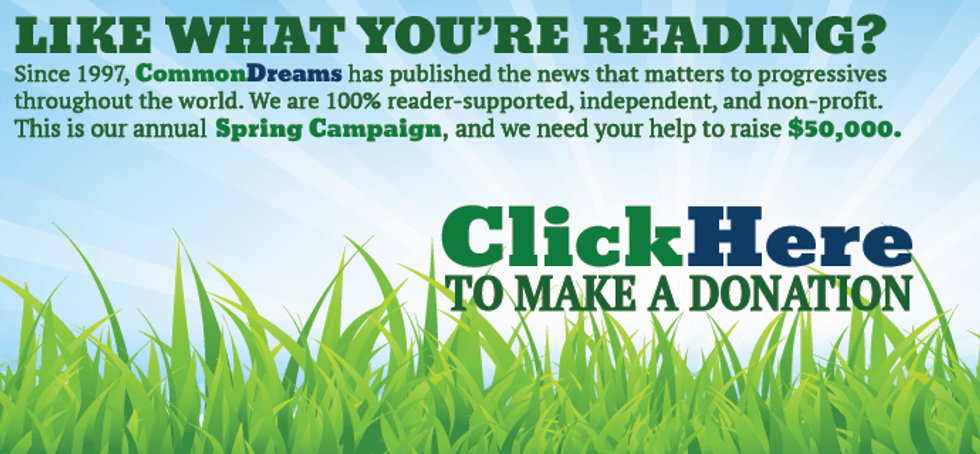Coinciding with growing income inequality, widespread economic stagnation, and a continued lack of basic health services during the same time period, a new federal report reveals a surging suicide rate among the U.S. population over the last three decades.
Published Friday by the National Center for Health Statistics, an arm of the Centers for Disease Control (CDC), the new report shows how--after a plateau in the 1980s and 90s--the suicide rate in the U.S. dramatically increased from 1999 to 2014, with the largest increase taking place after 2006. According to the CDC, suicide remains the 10th leading cause of death in the country.
"It's a broad-based increase in suicide," Sally Curtin, a statistician with the CDC and one of the report's main authors, told the PBS Newshour.
Among the key statistics contained in the report:
- From 1999 through 2014, the age-adjusted suicide rate in the United States increased 24%, from 10.5 to 13.0 per 100,000 population, with the pace of increase greater after 2006.
- Suicide rates increased from 1999 through 2014 for both males and females and for all ages 10-74.
- The percent increase in suicide rates for females was greatest for those aged 10-14, and for males, those aged 45-64.
- The most frequent suicide method in 2014 for males involved the use of firearms (55.4%), while poisoning was the most frequent method for females (34.1%).
According to the Guardian, "This new suicide data underpins recent studies that showed a decline in life expectancy among middle-aged, white Americans - especially women. Such studies attributed the increasing death rate to drug and alcohol misuse, as well as suicide. However, the NCHS data did not analyze racial and ethnic differences in suicide."
Though countless other studies have looked specifically at what drives individuals or various groups to suicide, Friday's NCHS report focuses on tracking the overall statistics and demographics while leaving the cause behind the trends largely unexamined.
As the Guardian notes, however, "a 2013 analysis from the [CDC] noted the recent economic downturn and a vulnerability among baby boomers who had 'unusually high suicide rates during their adolescent years' as possible contributing factors to the rising suicide rate for middle-aged adults."
And NPRreports how the national trend of "economic stagnation" during this same 30-year time period was leaving "more people out of jobs, and probably made it harder for people to access health care and treatment."
In concert with growing economic inequality, job loss, and the growing burden of personal debt, NPR's report explains why lack of health insurance is a key factor because too often people who take their own life "weren't covered or didn't have access to treatment for depression, the most common risk factor for suicide."
Kristin Holland, a behavioral scientist in the CDC's Division of Violence Prevention who was not involved in the current research, toldCNN that the "economic downturn" that took hold in the 2000s should certainly be considered a factor in the spiking rate.
"Many people view suicide as a mental health problem, but many people who die of suicide do not have a mental health problem. It's a public health problem," Holland said.
Bolstering the idea that financial factors play a key role in the surging suicide rate, an academic review of existing peer-reviewed research published on Friday reveals a consistent correlation between individual stress and broader economic crisis. Conducted by researchers in Italy, the abstract of the paper notes:
In 2008 a deep economic crisis started in the US and rapidly spread around the world. The crisis severely affected the labor market and employees' well-being. Hence, the aim of this work is to implement a systematic review of the principal studies that analyze the impact of the economic crisis on the health of workers. We conducted our search on the PubMed database, and a total of 19 articles were selected for review. All studies showed that the economic crisis was an important stressor that had a negative impact on workers' mental health. Most of the studies documented that a rise in unemployment, increased workload, staff reduction, and wages reduction were linked to an increased rate of mood disorders, anxiety, depression, dysthymia, and suicide.
In Europe, where economic crises driven by the 2007 global economic collapse and the severe austerity measures that followed have caused widespread hardship, numerous studies in recent years (here, here, and here) have shown how suicide rate increases go hand in hand with the implementation of neoliberal reforms, including the cutting of wages and pensions as well as reductions of public services.
Last year, an article published in the American Journal of Preventive Medicine also revealed that suicide rates among middle-aged Americans (aged 40 to 64) had climbed since 1999, including the same drastic increase since 2007 at the outset of the financial crisis.
According to the authors of that study, "The sharpest increase in external circumstances appears to be temporally related to the worst years of the Great Recession, consistent with other work showing a link between deteriorating economic conditions and suicide."

